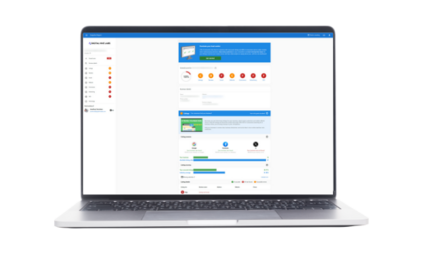Your guide to practical AI implementation strategies for small businesses

This guide outlines practical AI implementation strategies for small businesses, emphasizing the accessibility of affordable AI tools. It discusses identifying high-ROI processes for automation, enhancing customer service with AI, generating quality marketing content, and extracting actionable insights from data. A step-by-step implementation roadmap is provided, including how to measure the business impact of AI investments. The importance of a human + AI hybrid approach is highlighted, with real-world examples across industries demonstrating successful integration. Finally, a call to action invites businesses to get a free digital audit to explore tailored AI solutions.
The availability of affordable AI tools means that even smaller firms can automate processes and improve efficiency, enabling them to compete with larger companies. It’s essential for these businesses to start by identifying which tasks would benefit most from automation, such as customer support or inventory management. They should also consider implementing user-friendly solutions like chatbots and data analysis tools for insights. By following a clear roadmap for implementation, including testing and gathering feedback, small businesses can achieve meaningful results while maintaining their unique value in the market.
The accessibility revolution in business automation
The landscape of business automation has changed dramatically with the advent of accessible AI technologies. Small businesses can now utilize powerful AI tools that were once exclusive to large corporations. For instance, platforms like Zapier allow small businesses to automate repetitive tasks between apps without needing extensive technical knowledge. Additionally, AI-driven customer relationship management (CRM) systems, such as HubSpot, provide small business owners with insights that were traditionally available only to data analysts. These tools not only reduce labor costs but also enhance productivity by allowing employees to focus on higher-value tasks. As companies adopt these technologies, they can streamline operations and improve overall efficiency, ultimately leading to increased competitiveness in the marketplace.
Identifying high-ROI processes for automation
Before diving into implementation, it’s crucial for businesses to assess their processes and identify which tasks can yield the highest return on investment (ROI) when automated. Common areas include customer support, where automating responses to frequently asked questions can free up staff for more complex issues. Sales processes can also benefit, with AI assisting in lead scoring and nurturing potential customers more effectively. Inventory management is another area ripe for automation, as AI can streamline stock alerts and order processing, reducing human error and saving time.
To effectively assess automation opportunities, start by conducting process mapping to identify all operational tasks and their outputs. Next, evaluate which tasks consume the most time and resources. This will help you rank processes by their potential impact, considering factors like cost savings, time saved, and error reduction. By focusing on the highest ROI tasks, small businesses can maximize the benefits of their automation efforts.
|
Process |
Time Spent |
Resource Consumption |
Potential ROI |
|---|---|---|---|
|
Customer Support |
40 hours/week |
2 support agents |
High |
|
Sales Processes |
30 hours/week |
1 sales agent |
Medium |
|
Inventory Management |
15 hours/week |
1 inventory manager |
Medium |
Automating customer service with a personal touch
Automating customer service is essential for small businesses to improve efficiency while maintaining a personal connection with customers. Chatbots, like Drift and Intercom, can handle common inquiries around the clock, providing instant responses that enhance customer satisfaction. However, it’s critical to ensure these bots are well-trained. They should be programmed with human-like conversational skills and common customer queries to mimic genuine interactions.
Additionally, integrating AI-powered help desks such as Zendesk can streamline ticket management by automatically creating and prioritizing customer requests. This allows human agents to focus on more complex issues that require a personal touch.
Best practices for effective automation include regularly monitoring chatbot interactions to identify areas for improvement. By analyzing conversations, businesses can refine responses and enhance the overall customer experience. Combining automation with human oversight not only boosts efficiency but also ensures that customers feel valued and understood.
Creating quality marketing content with AI tools
AI tools can significantly enhance the marketing content creation process for small businesses. Tools like Copy.ai help generate engaging marketing copy, while Canva offers AI-assisted design features to create eye-catching visuals. It's essential to also optimize this content for search engines. For example, AI can provide invaluable insights into SEO, which can really help in today's competitive search market. To effectively use these tools, start by defining your target audience and understanding their preferences. Developing a content calendar helps ensure consistency and organization in your marketing efforts. Additionally, engaging with your audience through social media and monitoring feedback can provide insights to refine your content strategy. By analyzing engagement metrics, small businesses can adjust their approach to better resonate with their customers, making AI an invaluable partner in marketing.
Extracting actionable insights from data
AI can help small businesses make sense of their data, turning numbers into actionable insights. With tools like Google Analytics, companies can track website traffic and user behaviors, allowing them to understand which products are most popular or where customers drop off in the purchasing process. By visualizing data trends with platforms like Tableau, businesses can spot patterns and make informed decisions quickly.
To get started, gather data from various sources such as sales reports, customer feedback, and online engagement metrics. Automate your reporting process by setting up dashboards that display real-time insights on key performance indicators (KPIs). Focus on metrics that matter most to your strategy, like customer acquisition costs or lifetime value. This approach empowers small businesses to be proactive rather than reactive, using data to guide decisions and shape future strategies.
A step-by-step guide to implementing automation
To implement automation effectively, start by defining your objectives. Clearly state what you hope to achieve, such as reducing costs or improving efficiency. Next, research and select the appropriate AI tools that align with these goals. Choose solutions that are user-friendly and scalable for your business size.
After selecting your tools, conduct a pilot test. Start small with a specific process to evaluate how well the automation works. This allows you to iron out any issues before a full rollout. Gather feedback from employees who interact with the new system. Their insights can help identify any challenges and improvements needed.
Once the pilot is successful, proceed with full-scale implementation. Ensure that all team members receive adequate training on the new tools. Provide resources and support to help them adapt to the changes.
Finally, establish a routine for monitoring the automation’s performance. Track key metrics that reflect your business objectives. Use this data to make adjustments and enhance the automation over time, ensuring it continues to meet your evolving needs.
- Identify repetitive tasks that can be automated.
- Research suitable AI tools and platforms for your needs.
- Set clear objectives and goals for automation implementation.
- Create a detailed implementation plan with timelines.
- Train your team on the new tools and workflows.
- Test the automation processes in a controlled environment.
- Gather feedback and make adjustments as necessary.
- Monitor performance and results continuously.
Measuring the business impact of AI investments
To ensure that your AI investments are yielding returns, it’s vital to establish a clear framework for measuring their impact on your business. Start by setting specific metrics that align with your overall business goals, such as cost reductions, increased sales, or improved customer satisfaction. Before implementing AI solutions, gather baseline data to understand your current performance levels. After rolling out your AI tools, conduct a pre- and post-implementation analysis to compare the results. This analysis will highlight areas of improvement and help you assess whether your investment is paying off. For example, if you implemented an AI-powered chatbot, measure metrics like reduced customer response time and increased customer engagement. Lastly, continuously improve your AI strategies by analyzing the insights gained from your ROI assessments. This will help refine processes and ensure that your AI tools are consistently contributing to your business success.
The human + AI hybrid approach for small businesses
The Human + AI hybrid approach is essential for small businesses looking to optimize their operations while retaining their unique strengths. This strategy combines the efficiency of AI with the personal touch that only humans can provide. For instance, in retail, AI can handle initial customer inquiries through chatbots, but follow-up interactions can be managed by staff who can give personalized advice and build relationships. In healthcare, AI can streamline appointment scheduling, yet human professionals are crucial for providing compassionate patient care. This synergy allows businesses to enhance customer experiences without sacrificing the quality of service, ensuring that technology complements rather than replaces the human element.
Real-world implementation examples across industries
In the retail sector, small businesses can use AI chatbots to handle customer inquiries, ensuring that shoppers receive instant assistance while freeing up human staff for more complex interactions. For instance, a local clothing store might implement a chatbot on its website to answer questions about sizes and availability, followed by a personal follow-up from a sales associate to guide customers through their shopping experience.
In healthcare, small clinics can leverage AI tools for scheduling appointments, which streamlines the process and reduces wait times. By using AI to manage bookings, staff can focus on providing quality care. For example, a small dental practice could automate appointment reminders, allowing receptionists to spend more time with patients.
The hospitality industry also benefits from AI by utilizing recommendation systems that suggest services based on guest preferences. A boutique hotel might use AI to analyze past guest data and recommend activities during their stay, while still ensuring that staff members offer a warm welcome and personal assistance, thus combining automation with a personal touch.
Your next step: Get a free digital audit
To truly understand how AI can benefit your small business, the first step is to get a clear picture of your current digital landscape. A free digital audit can provide valuable insights into your operations, highlighting areas where AI implementation could lead to significant improvements. This audit will assess your existing processes, identify inefficiencies, and recommend tailored AI solutions that fit your specific needs. For example, it can reveal how automating customer interactions could save time and enhance service quality. By evaluating your digital presence, you can make informed decisions about where to implement AI for maximum impact. Take advantage of this opportunity to discover how AI can elevate your business.
Frequently asked questions
1. What is practical AI for small businesses?
Practical AI refers to using artificial intelligence tools and technologies that can help small businesses improve efficiency, enhance customer service, and make better decisions without needing a lot of technical expertise.
2. How can a small business start using AI?
A small business can start using AI by identifying specific problems it wants to solve, researching available tools that fit their needs, and gradually implementing these tools one at a time.
3. What are some examples of AI tools for small businesses?
Examples of AI tools for small businesses include chatbots for customer service, email marketing automation, inventory management systems, and data analytics tools that help in making informed decisions.
4. Do I need technical skills to implement AI in my business?
Not necessarily. Many AI tools are user-friendly and designed for non-technical users, but having a basic understanding of technology can be helpful for better implementation.
5. Can AI really benefit small businesses?
Yes, AI can significantly benefit small businesses by automating routine tasks, improving customer experiences, and providing valuable insights from data to aid in business decisions.

Ready to take the next step? Get your FREE digital marketing audit here. We’ll help you identify the most cost-effective strategies for your unique business needs.